- Recent Articles
- Most Citedi
- Most Visitedi
- Future Articles
-
Original Article06-27-2002
The Trial of Labor After one Cesarean Section
- Iracema de Mattos Paranhos Calderon,
- Jacqueline Leite Frade,
- Joelcio Francisco Abbade,
- Carolina Prado Diniz,
- Ivete Dalben, [ … ],
- Marilza Vieira Cunha Rudge
Views61

This is an Open Access article distributed under the terms of the Creative Commons Attribution License, which permits unrestricted use, distribution, and reproduction in any medium, provided the original work is properly cited. Abstract
Original ArticleThe Trial of Labor After one Cesarean Section
Revista Brasileira de Ginecologia e Obstetrícia. 2002;24(3):161-166
DOI 10.1590/S0100-72032002000300003
- Iracema de Mattos Paranhos Calderon,
- Jacqueline Leite Frade,
- Joelcio Francisco Abbade,
- Carolina Prado Diniz,
- Ivete Dalben,
- Marilza Vieira Cunha Rudge
Views61See morePurpose: to study trial of labor (TOL) for vaginal birth after one previous cesarean section. Methods: this is a retrospective cohort study that included 438 pregnant women with one previous cesarean section and their 450 newborns. They were divided into two groups – with and without TOL. The minimum sample size was 121 pregnant mothers per group. TOL was considered as an independent variable and vaginal birth and maternal and perinatal complication frequency as dependent variables. Both univariate and multivariate analyses were performed. The comparison of observed frequencies (%) was analyzed by the chi-squared test (chi²) with 5% significance, and linear regression from the odds ratio (OR) and confidence interval of 95% (CI95%). Results: TOL was used in 59.2% of vaginal deliveries. It was less used in women over 40 years (2.7% vs 6.7%) and in those with clinical or obstetrical diseases such as arterial hypertension (7.0%) and bleeding in the third trimester (0.3%). There was a higher risk for puerperal complications with cesarean deliveries (OR = 3.53, CI 95% = 1.57-7.93), independent of TOL. Perinatal mortality was dependent on neonatal weight and fetal malformations, not on TOL. Newborns from mothers not submitted to TOL were at a higher risk for developing breathing complications (OR = 1.92 CI 95% = 1.20-3.07). Conclusions: The results confirm that trial of labor after a previous cesarean section is a safe method – assisting vaginal delivery in 59.2% of births and not interfering with maternal and perinatal mortality. It is a treatment that should be stimulated.


This is an Open Access article distributed under the terms of the Creative Commons Attribution License, which permits unrestricted use, distribution, and reproduction in any medium, provided the original work is properly cited. -
DECLARAÇÃO DE BARCELONA
Revista Brasileira de Ginecologia e Obstetrícia. 2002;24(3):151-151
Abstract


This is an Open Access article distributed under the terms of the Creative Commons Attribution License, which permits unrestricted use, distribution, and reproduction in any medium, provided the original work is properly cited. -
A Grande Vitória
Revista Brasileira de Ginecologia e Obstetrícia. 2002;24(1):07-07
Views60

This is an Open Access article distributed under the terms of the Creative Commons Attribution License, which permits unrestricted use, distribution, and reproduction in any medium, provided the original work is properly cited. Abstract


This is an Open Access article distributed under the terms of the Creative Commons Attribution License, which permits unrestricted use, distribution, and reproduction in any medium, provided the original work is properly cited. -
Original Article06-20-2002
Microinvasive Carcinoma in the Cone Specimen in Women With Colposcopically Directed Biopsy Suggesting CIN 3
- Priscila Garcia Figueiredo,
- Renata Clementino Gontijo,
- Sophie Françoise Mauricette Derchain,
- Fabiana Yumi Nakano,
- Julio César Teixeira, [ … ],
- Edson Zangiacomi Martinez
Views52

This is an Open Access article distributed under the terms of the Creative Commons Attribution License, which permits unrestricted use, distribution, and reproduction in any medium, provided the original work is properly cited. Abstract
Original ArticleMicroinvasive Carcinoma in the Cone Specimen in Women With Colposcopically Directed Biopsy Suggesting CIN 3
Revista Brasileira de Ginecologia e Obstetrícia. 2002;24(1):37-43
DOI 10.1590/S0100-72032002000100006
- Priscila Garcia Figueiredo,
- Renata Clementino Gontijo,
- Sophie Françoise Mauricette Derchain,
- Fabiana Yumi Nakano,
- Julio César Teixeira,
- Edson Zangiacomi Martinez
Views52See morePurpose: to determine the factors associated with the detection of a microinvasive carcinoma in the cervical cone of women with a previous colposcopically directed biopsy compatible with cervical intraepithelial neoplasia (CIN) 3 and to evaluate the proportion of involved margins. Patients and methods: we reviewed the medical records of 385 women (mean age: 39 years) submitted to cold conization or conization by high frequency surgery (HFS) with a loop during the period from January 1993 to July 2000. These procedures were indicated on the basis of a biopsy compatible with (CIN) 3. Results: the diagnosis of the cone was compatible with (CIN) 3 in 243 (63%) women and with (CIN) 2 in 13 (3%). Only 10 presented HPV/CIN 1 (3%) and eight had no residual disease in the cone. However, 101 (26%) women presented a microinvasive carcinoma in the cone and 10 (3%) presented a frankly invasive carcinoma. Age, menstrual status and number of deliveries were not related to the severity of the cone lesion. Women with oncologic colpocytology changes suggestive of invasion presented a significantly higher risk of having a microinvasive or invasive carcinoma as determined by final histology (p<0.01), although 52 of the 243 women with CIN 2 or CIN 3 in the cone also showed a suggestion of invasion at colpocytology. Among the women with CIN 2 or 3, the epithelium was white in 44%, dotted in 21%, and mosaic-like in 17%. This proportion was similar for women with a microinvasive or invasive carcinoma, with these images being detected in 37%, 23% and 21% of the cases, respectively. Involvement of the cone margins was significantly higher among women submitted to HFS (49%) than among those submitted to cold conization (29%). Conclusion: the absence of independent clinical and colposcopic factors associated with the detection of a microinvasive carcinoma in women submitted to conization on the basis of a biopsy compatible with (CIN) 3 justifies the conical excision of the squamocolumnar junction in high grade cervical lesions.


This is an Open Access article distributed under the terms of the Creative Commons Attribution License, which permits unrestricted use, distribution, and reproduction in any medium, provided the original work is properly cited. -
Erratum06-19-2002Revista Brasileira de Ginecologia e Obstetrícia. 2002;24(1)
Abstract
ErratumRevista Brasileira de Ginecologia e Obstetrícia. 2002;24(1)
DOI 10.1590/S0100-72032002000100018
Views27Associação entre a incisura Diastólica das artérias uterinas e a histologia do leito placentário em grávidas com pré-eclâmpsia […]See more

This is an Open Access article distributed under the terms of the Creative Commons Attribution License, which permits unrestricted use, distribution, and reproduction in any medium, provided the original work is properly cited. -
Resumos de Teses06-19-2002
Contribuição ao Estudo do Laser de Vapor de Cobre no Tratamento da Endometriose Induzida Cirurgicamente em Coelhas
Revista Brasileira de Ginecologia e Obstetrícia. 2002;24(1):71-71
Abstract
Resumos de TesesContribuição ao Estudo do Laser de Vapor de Cobre no Tratamento da Endometriose Induzida Cirurgicamente em Coelhas
Revista Brasileira de Ginecologia e Obstetrícia. 2002;24(1):71-71
DOI 10.1590/S0100-72032002000100017
Views49Contribuição ao Estudo do Laser de Vapor de Cobre no Tratamento da Endometriose Induzida Cirurgicamente em Coelhas […]See more

This is an Open Access article distributed under the terms of the Creative Commons Attribution License, which permits unrestricted use, distribution, and reproduction in any medium, provided the original work is properly cited. -
Resumos de Teses06-19-2002
Avaliação do Potencial de Peroxidação Lipídica no Fluido Peritoneal de Mulheres Inférteis com Endometriose Pélvica
Revista Brasileira de Ginecologia e Obstetrícia. 2002;24(1):70-70
Abstract
Resumos de TesesAvaliação do Potencial de Peroxidação Lipídica no Fluido Peritoneal de Mulheres Inférteis com Endometriose Pélvica
Revista Brasileira de Ginecologia e Obstetrícia. 2002;24(1):70-70
DOI 10.1590/S0100-72032002000100016
Views56Avaliação do Potencial de Peroxidação Lipídica no Fluido Peritoneal de Mulheres Inférteis com Endometriose Pélvica […]See more

This is an Open Access article distributed under the terms of the Creative Commons Attribution License, which permits unrestricted use, distribution, and reproduction in any medium, provided the original work is properly cited. -
Resumos de Teses06-19-2002
Prevalência das Neoplasias Intra-epiteliais Cervicais e Lesões Induzidas pelo HPV nas Mulheres Soropositivas/AIDS
Revista Brasileira de Ginecologia e Obstetrícia. 2002;24(1):70-70
Abstract
Resumos de TesesPrevalência das Neoplasias Intra-epiteliais Cervicais e Lesões Induzidas pelo HPV nas Mulheres Soropositivas/AIDS
Revista Brasileira de Ginecologia e Obstetrícia. 2002;24(1):70-70
DOI 10.1590/S0100-72032002000100015
Views42Prevalência das Neoplasias Intra-epiteliais Cervicais e Lesões Induzidas pelo HPV nas Mulheres Soropositivas/AIDS […]See more

This is an Open Access article distributed under the terms of the Creative Commons Attribution License, which permits unrestricted use, distribution, and reproduction in any medium, provided the original work is properly cited.
-
FEBRASGO POSITION STATEMENT05-16-2025
Mayer-Rokitansky-Kuster-Hauser syndrome
Revista Brasileira de Ginecologia e Obstetrícia. 2025;47:e-FPS4
Abstract
FEBRASGO POSITION STATEMENTMayer-Rokitansky-Kuster-Hauser syndrome
Revista Brasileira de Ginecologia e Obstetrícia. 2025;47:e-FPS4
Views47See moreKey points
•Mayer-Rokitansky-Kuster-Hauser syndrome (MRKH) is the leading cause of vaginal agenesis.
•It is characterized by primary amenorrhea with typical adrenarche and telarche and may be associated with congenital urological and skeletal conditions that should be investigated.
•Differential diagnoses include: vaginal obstructions (imperforate hymen, distal vaginal atresia, transverse vaginal septum), uterine obstructions (cervical atresia), and differences in sexual development (gonadal dysgenesis, complete androgen insensitivity and congenital adrenal hyperplasia due to CYP17 deficiency).
•Laboratory tests (testosterone, follicle-stimulating hormone [FSH] and karyotype) and radiological tests (pelvic ultrasound and MRI) are necessary.
•Vaginal dilation is the first line of treatment with high success rates.


This is an Open Access article distributed under the terms of the Creative Commons Attribution License, which permits unrestricted use, distribution, and reproduction in any medium, provided the original work is properly cited. 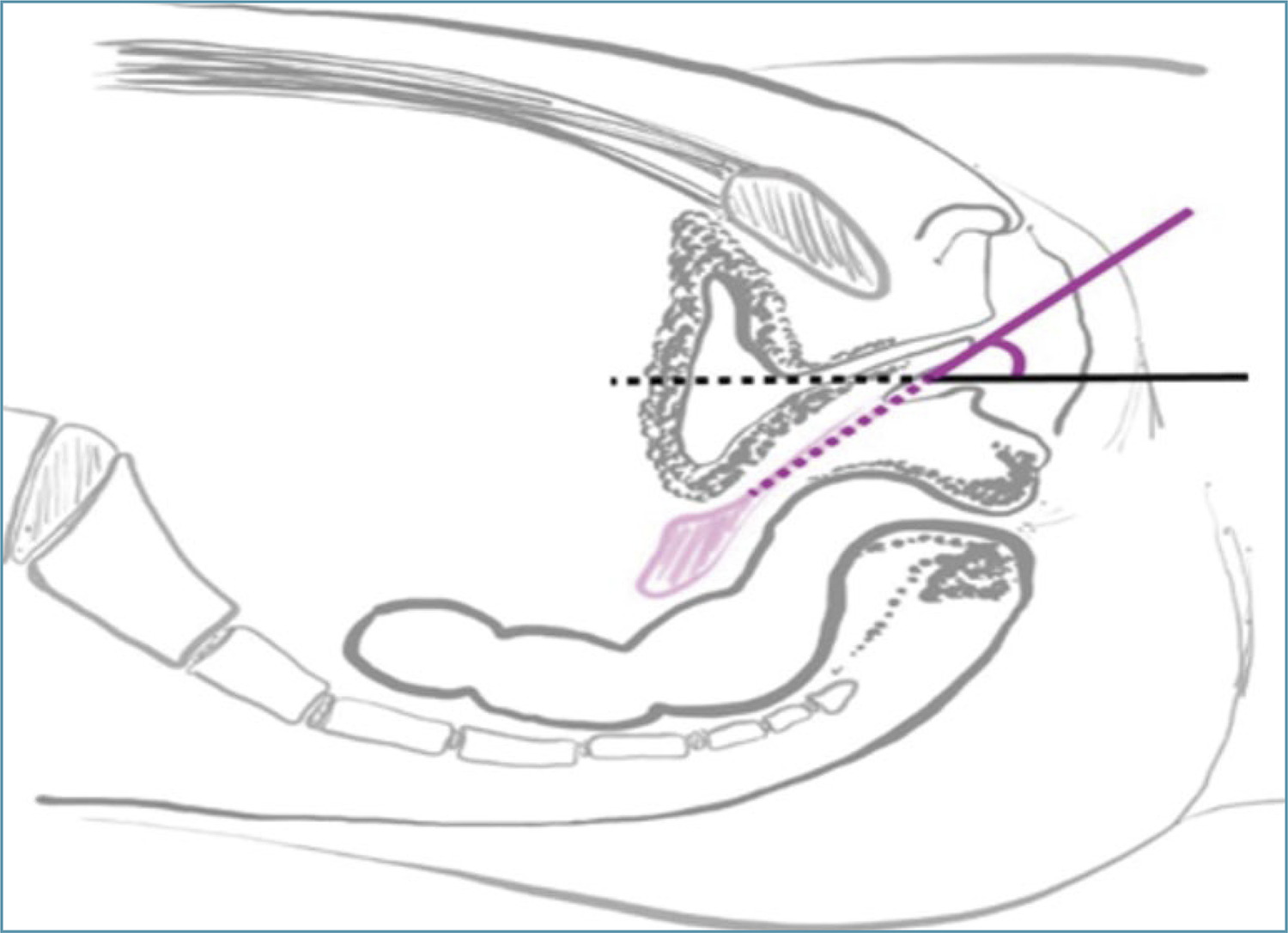
-
Original Article04-30-2025
Depression, anxiety, sexual function and quality of life in women with hyperprolactinemia
- Renan Massao Nakamura
 ,
, - Daniela Angerame Yela
 ,
, - Amanda Carvalho Santos
 ,
, - Beatriz Cipriano Ribas
 ,
, - Pedro Henrique Silva Rosa e
 , [ … ],
, [ … ], - Cristina Laguna Benetti-Pinto

Abstract
Original ArticleDepression, anxiety, sexual function and quality of life in women with hyperprolactinemia
Revista Brasileira de Ginecologia e Obstetrícia. 2025;47:e-rbgo7
- Renan Massao Nakamura
 ,
, - Daniela Angerame Yela
 ,
, - Amanda Carvalho Santos
 ,
, - Beatriz Cipriano Ribas
 ,
, - Pedro Henrique Silva Rosa e
 ,
, - Bianca Netto Motta
 ,
, - Gabriela Pravatta Rezende
 ,
, - Cristina Laguna Benetti-Pinto

Views57Abstract
Objective:
To evaluate anxiety, depression, sexual function and quality of life in women with hyperprolactinemia.
Methods:
Cross-sectional study with 80 women divided into two groups: 30 women with hyperprolactinemia (Study Group) followed and treated at the endocrine gynecology outpatient clinic and 50 women without hyperprolactinemia, with regular menstrual cycles (Control Group) followed at the family planning outpatient clinic of the State University of Campinas from June 2021 to October 2022. Sociodemographic characteristics, quality of life (SF-36 Questionnaire), sexual function (Female Sexual Function Index Questionnaire), depression (Beck Depression Inventory) and anxiety (Beck Anxiety Scale) were evaluated in both groups. Categorical variables were described as absolute frequency and percentage; numerical variables as mean and standard deviation. Comparison of numerical variables between two groups was performed by Mann-Whitney test, while categorical were compared by Chi-Square or Fisher’s exact tests.
Results:
The mean age of women with hyperprolactinemia was 39.6±8.1 years and the Control Group was 31.2±9.5 years (p<0.001). There was no difference in anxiety scores (p=0.66), depression (p=0.08) and general sexual function (p=0.08) in both groups. However, women with hyperprolactinemia had lower scores in the domains of pain and arousal and worse functional capacity than Control Group (p<0.05).
Conclusion:
Women with hyperprolactinemia under treatment do not show any impairment in their anxiety, depression and sexual function when compared to women without hyperprolactinemia. However, analysis of quality of life showed that women with hyperprolactinemia have poor functional capacity.
Key-words AnxietyDepressionHyperpituitarismHyperprolactinemiaQuality of lifesexual functionsurveys and questionnairesSee more

This is an Open Access article distributed under the terms of the Creative Commons Attribution License, which permits unrestricted use, distribution, and reproduction in any medium, provided the original work is properly cited. - Renan Massao Nakamura
-
Original Article04-30-2025
Hysterectomy rates per resident in final year of training in teaching hospitals: an ecologic study
- Luiza Nestori Chiozzotto
 ,
, - Nino José Wilson Moterani Júnior
 ,
, - Laura Bresciani Bento Gonçalves Moterani
 ,
, - Vinicius César Moterani
 ,
, - Francisco José Candido dos Reis

Abstract
Original ArticleHysterectomy rates per resident in final year of training in teaching hospitals: an ecologic study
Revista Brasileira de Ginecologia e Obstetrícia. 2025;47:e-rbgo24
- Luiza Nestori Chiozzotto
 ,
, - Nino José Wilson Moterani Júnior
 ,
, - Laura Bresciani Bento Gonçalves Moterani
 ,
, - Vinicius César Moterani
 ,
, - Francisco José Candido dos Reis

Views98Abstract
Objective:
Analyze the hysterectomy rates per resident in graduation year in teaching hospitals in the state of São Paulo (Brazil).
Methods:
We selected teaching hospitals in the state of São Paulo and gathered information from two public databases to estimate the hysterectomy rates per resident in their final year of training between 2009 and 2019.
Results:
Between 2009 and 2019, there was a 37.5% increase in the number of residents in their final year of training, a 4.31% increase in the number of hysterectomies, and a drop in the hysterectomy rates per resident of 24.1%. The reduction of the rate of hysterectomy per resident was more pronounced for vaginal route (46.4%) followed by abdominal route (23.3%). The ratio of laparoscopic hysterectomy per resident increased 264% during the period, however, this route was used in only 7% of the surgeries in 2019.
Conclusions:
The hysterectomy rates per resident in their final year of training showed a notable reduction. This trend, particularly pronounced in vaginal and abdominal routes, signals a shift towards minimally invasive techniques.
Key-words Clinical competenceEducation, medicalHospitals, teachingHysterectomylearning curveMedical staff, hospitalPhysiciansStudents, medicalSurgical procedures, operativeSee more

This is an Open Access article distributed under the terms of the Creative Commons Attribution License, which permits unrestricted use, distribution, and reproduction in any medium, provided the original work is properly cited. 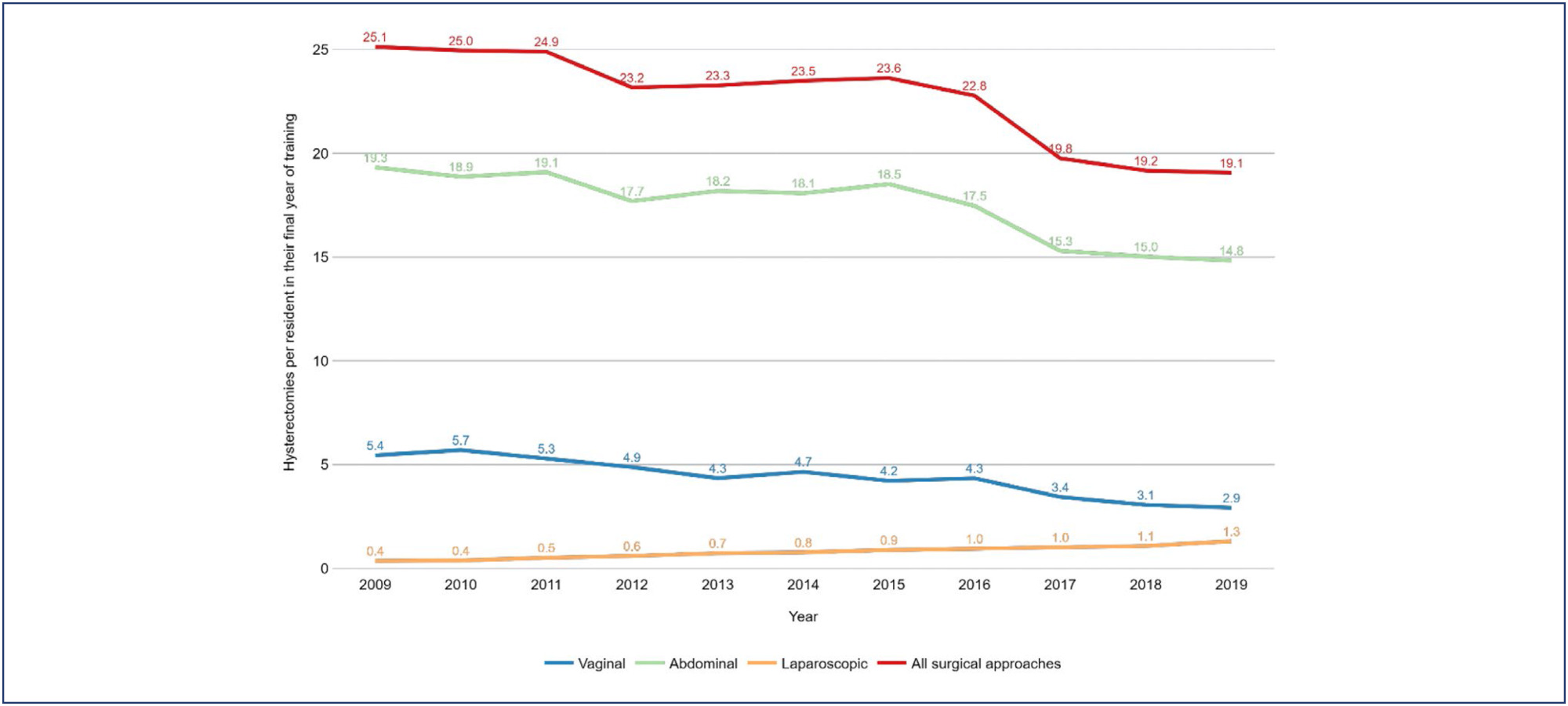
- Luiza Nestori Chiozzotto
-
Original Article04-30-2025
Prevalence of antiphospholipid syndrome among women with recurrent pregnancy loss: a cohort study
- Elaine Cristina Fontes de Oliveira
 ,
, - Daniel Dias Ribeiro
 ,
, - Janaína Campos Senra
 ,
, - Fernando Marcos dos Reis

Abstract
Original ArticlePrevalence of antiphospholipid syndrome among women with recurrent pregnancy loss: a cohort study
Revista Brasileira de Ginecologia e Obstetrícia. 2025;47:e-rbgo23
- Elaine Cristina Fontes de Oliveira
 ,
, - Daniel Dias Ribeiro
 ,
, - Janaína Campos Senra
 ,
, - Fernando Marcos dos Reis

Views89Abstract
Objective:
This study aimed to evaluate the prevalence of antiphospholipid syndrome (APS) among women experiencing recurrent pregnancy loss (RPL).
Methods:
A cross-sectional was conducted, reviewing the medical records of 134 women with a history of two or more miscarriages, treated between January 2014 and May 2024 at a tertiary university center in Belo Horizonte, Brazil. APS screening was performed by assessing anticardiolipin (IgG and IgM), lupus anticoagulant, and anti-β2-glycoprotein-1 (IgG and IgM) antibodies, based on Sapporo criteria. All tests were performed during non-pregnant periods and at least 12 weeks after the last miscarriage.
Results:
The study included 134 women with a mean age of 33.8 ± 5.7 years. The number of prior miscarriages ranged from 2 to 11 per couple. Among the patients who presented the lupus anticoagulant, only two (1.49%) tested positive in two samples, as per revised Sapporo criteria. Considering IgG and IgM anticardiolipin antibodies, four patients (2.98%) tested positive in two samples according to old Sapporo criteria, with one patient having a positive IgG test in two samples, two having positive IgM in two samples and a single patient having both positive tests. None of the 56 patients tested positive for anti-β2-glycoprotein-1 antibodies in two samples.
Conclusion:
The prevalence of antiphospholipid antibodies, in line with revised Sapporo criteria, is low among Brazilian women with recurrent pregnancy loss, consistent with recent studies in literature. Ensuring the appropriateness of diagnostic criteria is crucial to avoid unnecessary treatment with platelet anticoagulants and heparin in this population.
Key-words Abortion, habitualAbortion, spontaneousAntibodiesAnticardiolipinAntiphospholipid syndromePrevalenceThrombophiliaSee more

This is an Open Access article distributed under the terms of the Creative Commons Attribution License, which permits unrestricted use, distribution, and reproduction in any medium, provided the original work is properly cited. - Elaine Cristina Fontes de Oliveira
-
Original Article04-30-2025
An assessment of total antioxidant and oxidant parameters and their correlation with embryo quality in in-vitro fertilization patients
Revista Brasileira de Ginecologia e Obstetrícia. 2025;47:e-rbgo22
Abstract
Original ArticleAn assessment of total antioxidant and oxidant parameters and their correlation with embryo quality in in-vitro fertilization patients
Revista Brasileira de Ginecologia e Obstetrícia. 2025;47:e-rbgo22
Views86Abstract
Objective:
In vitro, fertilization is the primary treatment method for infertility. Follicular fluid analysis is an approach used to optimize the results of assisted reproductive techniques. Oxidative stress represents the imbalance between the production of reactive oxygen species and their detoxification. Total Antioxidant and Oxidant Status, and Oxidative Stress Index levels are the main oxidative stress markers. This study investigated the effects of oxidative stress markers on infertility etiology, embryo quality, and success of In vitro fertilization.
Methods:
Before enrolling in the ICSI-ET cycle, participants had their FSH and LH levels assessed on the second day of the cycle. The ovarian degrees of the participants were evaluated by transvaginal ultrasonography. Participants underwent controlled ovarian stimulation using the GnRH antagonist protocol. TV-USG and serial E2 measurements were performed at appropriate intervals to follow follicular development. Follicle sizes, quantity, and endometrial thickness were recorded. Total Antioxidant and Oxidant Status, and Oxidative analyses were conducted using Rel Assay Diagnostics Assay Kits.
Results:
The average number of total oocytes in the participants was 10.25±6.66, and the average of mature M2 stage oocytes was 6.71±3.72. The average number of fertilized oocytes was 4.65±2.81. Fertilization rates were calculated as approximately 54.75±25.58%. A statistically significant positive correlation was found between embryo quality and serum Total Antioxidant Status levels (p=0.004). Similarly, a significant positive correlation was observed between embryo quality and follicular Total Antioxidant Status values (r = 0.42, p = 0.01).
Conclusion:
This study concluded that oxidative stress markers affect certain stages of the IVF treatment process.
Key-words AntioxidantsFertilization in vitroFollicular fluidInfertilityOocytesOxidantsOxidative stressSee more

This is an Open Access article distributed under the terms of the Creative Commons Attribution License, which permits unrestricted use, distribution, and reproduction in any medium, provided the original work is properly cited. 
-
Review Article04-30-2025
Letrozole and clomiphene versus letrozole alone for ovulation induction in women with PCOS: a systematic review and meta-analysis
- Karine Eskandar
 ,
, - Juliana Almeida Oliveira
 ,
, - Sandro Augusto Ribeiro
 ,
, - Matheus Pedrotti Chavez
 ,
, - Ana Isabela de Araujo Zotti
 , [ … ],
, [ … ], - Andrea Mora de Marco Novellino

Abstract
Review ArticleLetrozole and clomiphene versus letrozole alone for ovulation induction in women with PCOS: a systematic review and meta-analysis
Revista Brasileira de Ginecologia e Obstetrícia. 2025;47:e-rbgo21
- Karine Eskandar
 ,
, - Juliana Almeida Oliveira
 ,
, - Sandro Augusto Ribeiro
 ,
, - Matheus Pedrotti Chavez
 ,
, - Ana Isabela de Araujo Zotti
 ,
, - Yasmin Jardim Meirelles Dias
 ,
, - Andrea Mora de Marco Novellino

Views100Abstract
Objective:
We aimed to compare the efficacy and safety of letrozole and clomiphene versus letrozole alone for ovulation induction in patients with Polycystic Ovary Syndrome (PCOS).
Data Sources:
We systematically searched EMBASE, PubMed, and Cochrane databases on October 31, 2024.
Study selection:
We included studies of women with PCOS treated with a combination of clomiphene and letrozole or letrozole alone to induce ovulation that reported any of the outcomes of interest, namely rate of mature follicles and ovulation, ovulation, pregnancy, miscarriages, endometrial thickness, and number of mature follicles.
Data collection:
We pooled odds ratios (OR) and mean difference (MD) with 95% confidence intervals (CI) using a random effects model using R statistical software, version 4.2.1. Heterogeneity was assessed with I statistics, and a random effects model was used.
Data Synthesis:
Four RCTs and two observational studies comprising 592 patients were included. Combined therapy was associated with a higher rate of a mature follicle (OR 2.74; 95% CI 1.72-4.37; p< 0.001; I=0%) and ovulation (OR 2.55; 95% CI 1.57-4.12; p< 0.001; I=35.9%). The number of mature follicles, number of pregnancies, thickness of endometrial lining, and the incidence of adverse events, including headache, abdominal bloating, fatigue, back pain, breast discomfort, and night sweats, were similar between groups.
Conclusion:
In women with anovulatory infertility secondary to PCOS, letrozole and clomiphene citrate combined therapy was associated with improved mature follicle and ovulation rates, with a similar safety profile compared to letrozole alone. However, no significant impact was observed on pregnancy rates.
Key-words ClomipheneInfertility, femaleLetrozoleOvulationOvulation InductionPolycystic ovary syndromeSee more

This is an Open Access article distributed under the terms of the Creative Commons Attribution License, which permits unrestricted use, distribution, and reproduction in any medium, provided the original work is properly cited. 
- Karine Eskandar
-
Original Article04-30-2025
Incidence of small-for-gestational-age newborns in pregnant women with COVID-19
- Gustavo dos Santos Raupp
 ,
, - Renato Teixeira Souza
 ,
, - Maria Laura Costa
 ,
, - Jose Guilherme Cecatti
 ,
, - Annerose Barros
 , [ … ],
, [ … ], - Janete Vettorazzi

Abstract
Original ArticleIncidence of small-for-gestational-age newborns in pregnant women with COVID-19
Revista Brasileira de Ginecologia e Obstetrícia. 2025;47:e-rbgo20
- Gustavo dos Santos Raupp
 ,
, - Renato Teixeira Souza
 ,
, - Maria Laura Costa
 ,
, - Jose Guilherme Cecatti
 ,
, - Annerose Barros
 ,
, - Ellen Machado Arlindo
 ,
, - Edson Vieira Cunha Filho
 ,
, - Janete Vettorazzi

Views82Abstract
Objective:
This study aimed to assess the incidence of small for gestational age (SGA) newborns in pregnant women infected with COVID-19 and examine the associated neonatal outcomes.
Methods:
This study involved a secondary analysis of the REBRACO Network, a prospective cohort study conducted in 15 maternity hospitals in Brazil before the introduction of COVID-19 vaccination (February 2020 to February 2021). Demographic data of pregnant women tested for COVID-19 were analyzed, and fetal outcomes were compared between women with positive and negative COVID-19 results who had SGA fetuses.
Results:
A total of 729 symptomatic pregnant women with COVID-19 were included in the study. However, there were 248 participants with missing information regarding childbirth or loss of follow-up, and 107 participants without confirmatory tests for COVID-19. Among the remaining participants, 198 had confirmed COVID-19 and 176 tested negative. The incidence of SGA among women with COVID-19 was 22.4%, whereas the incidence among women who tested negative for COVID-19 was 14.8%. SGA newborns born to COVID-19 positive pregnant women were 1.6 times more likely to experience adverse outcomes (such as prematurity, stillbirth, neonatal death, and admission to a neonatal ICU) compared to non-SGA newborns [OR = 1.655 (1.145 – 2.394); P=0.017]. In SGA newborns of pregnant women with confirmed COVID-19 infection, mechanical ventilation use was found to be associated with the infection [OR = 0.692 (0.562 – 0.853); P=0.002].
Conclusion:
The higher incidence of SGA newborns and its stronger association with prematurity in pregnant women with confirmed COVID-19 infection suggest that COVID-19 infection is a significant factor contributing to neonatal morbidity and mortality.
Key-words coronavirus infectionsCOVID-19Infant, newbornInfant, small for gestational agematernal healthPregnancy complicationsSee more

This is an Open Access article distributed under the terms of the Creative Commons Attribution License, which permits unrestricted use, distribution, and reproduction in any medium, provided the original work is properly cited. 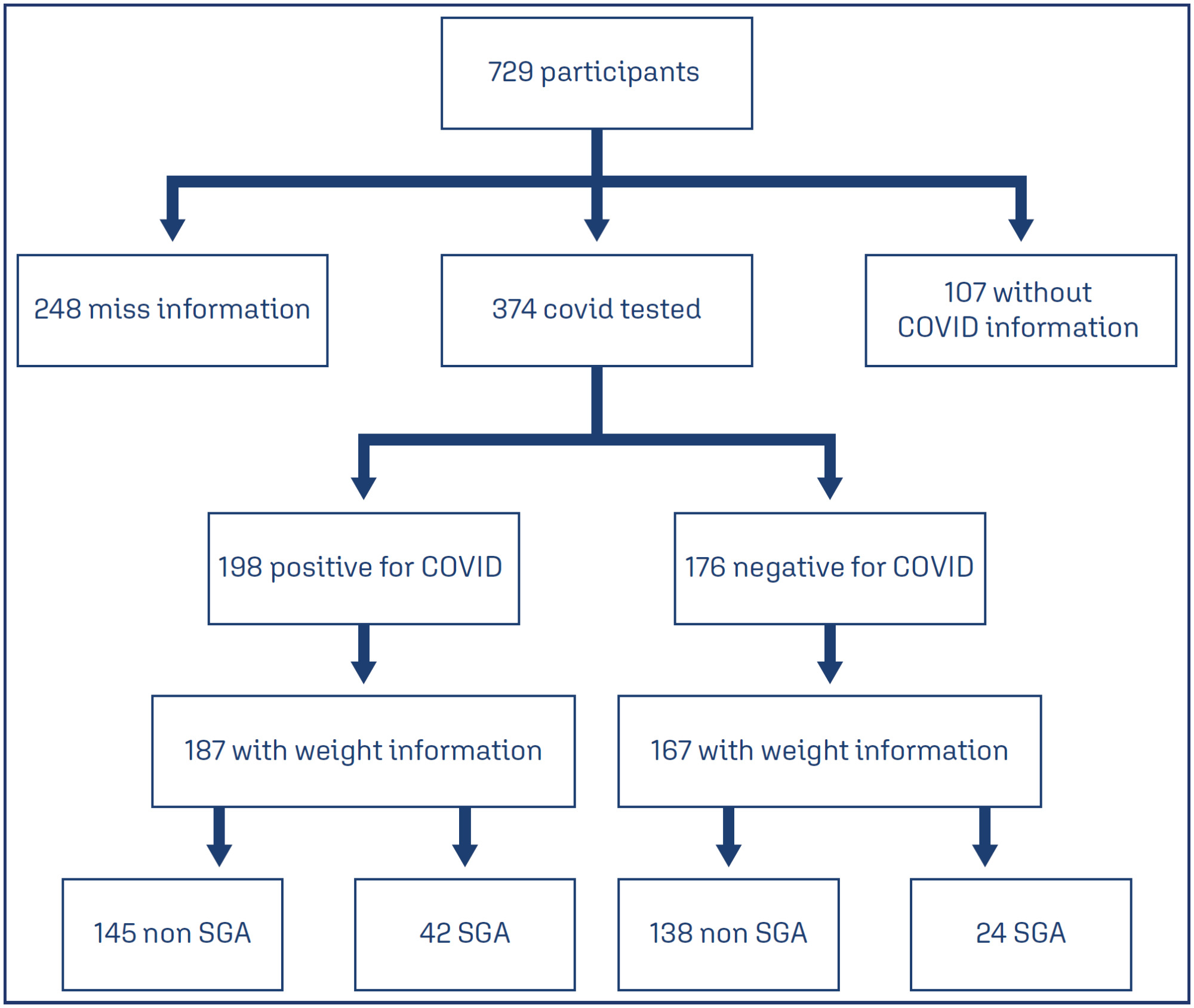
- Gustavo dos Santos Raupp
-
Review Article04-30-2025
Efficacy of tranexamic acid application in gynecology and obstetrics procedures: a umbrella review of systematic reviews of randomized trials
- Nicole Cristina Lottermann
 ,
, - Nathalia Luiza Andreazza
 ,
, - Matheus de Araújo Moura Cavalcante
 ,
, - Laura Andrade Fernandez
 ,
, - Carla Vitola Gonçalvez
 , [ … ],
, [ … ], - Linjie Zhang

Abstract
Review ArticleEfficacy of tranexamic acid application in gynecology and obstetrics procedures: a umbrella review of systematic reviews of randomized trials
Revista Brasileira de Ginecologia e Obstetrícia. 2025;47:e-rbgo18
- Nicole Cristina Lottermann
 ,
, - Nathalia Luiza Andreazza
 ,
, - Matheus de Araújo Moura Cavalcante
 ,
, - Laura Andrade Fernandez
 ,
, - Carla Vitola Gonçalvez
 ,
, - Linjie Zhang

Views86Abstract
Objective:
This umbrella review aimed to synthesize evidence from systematic reviews of clinical trials on the efficacy of tranexamic acid in gynecology and obstetrics procedures.
Methods:
We searched Medline, Embase, SciELO and Cochrane Database of Systematic Reviews on March 11, 2024, using the term “tranexamic acid”. Four reviewers independently select studies and extract data. We assessed the quality of systematic review and the quality of evidence, using AMSTAR 2 and GRADE tools, respectively.
Results:
Of 651 systematic reviews identified, 16 reviews with 96663 patients were included. The surgical procedures were cesarean section, myomectomy, hysterectomy, and cervical intraepithelial neoplasia surgery. All reviews showed a statistically significant and clinically relevant reduction in intraoperative and post-procedure blood loss, associated with intravenous or topical use of tranexamic acid. Tranexamic acid resulted in a significant reduction in the need for blood transfusions and a less pronounced drop in postoperative hematocrit and hemoglobin levels in cesarean section. Several reviews addressed the same question, but the number of included trials varied substantially, which might indicate flaws in search and selection of studies of these reviews. The quality of systematic reviews was low or critically low, and the quality of evidence was moderate.
Conclusions:
This umbrella review shows that tranexamic acid can reduce blood loss and hemorrhage in gynecology and obstetrics procedures. High quality systematic reviews are still needed.
Key-words Blood transfusionCesarean sectionEfficacyGynecologic surgical procedureshematocritHemorrhageHysterectomyObstetric surgical proceduresTranexamic acidUterine cervical dysplasiauterine myomectomySee more

This is an Open Access article distributed under the terms of the Creative Commons Attribution License, which permits unrestricted use, distribution, and reproduction in any medium, provided the original work is properly cited. 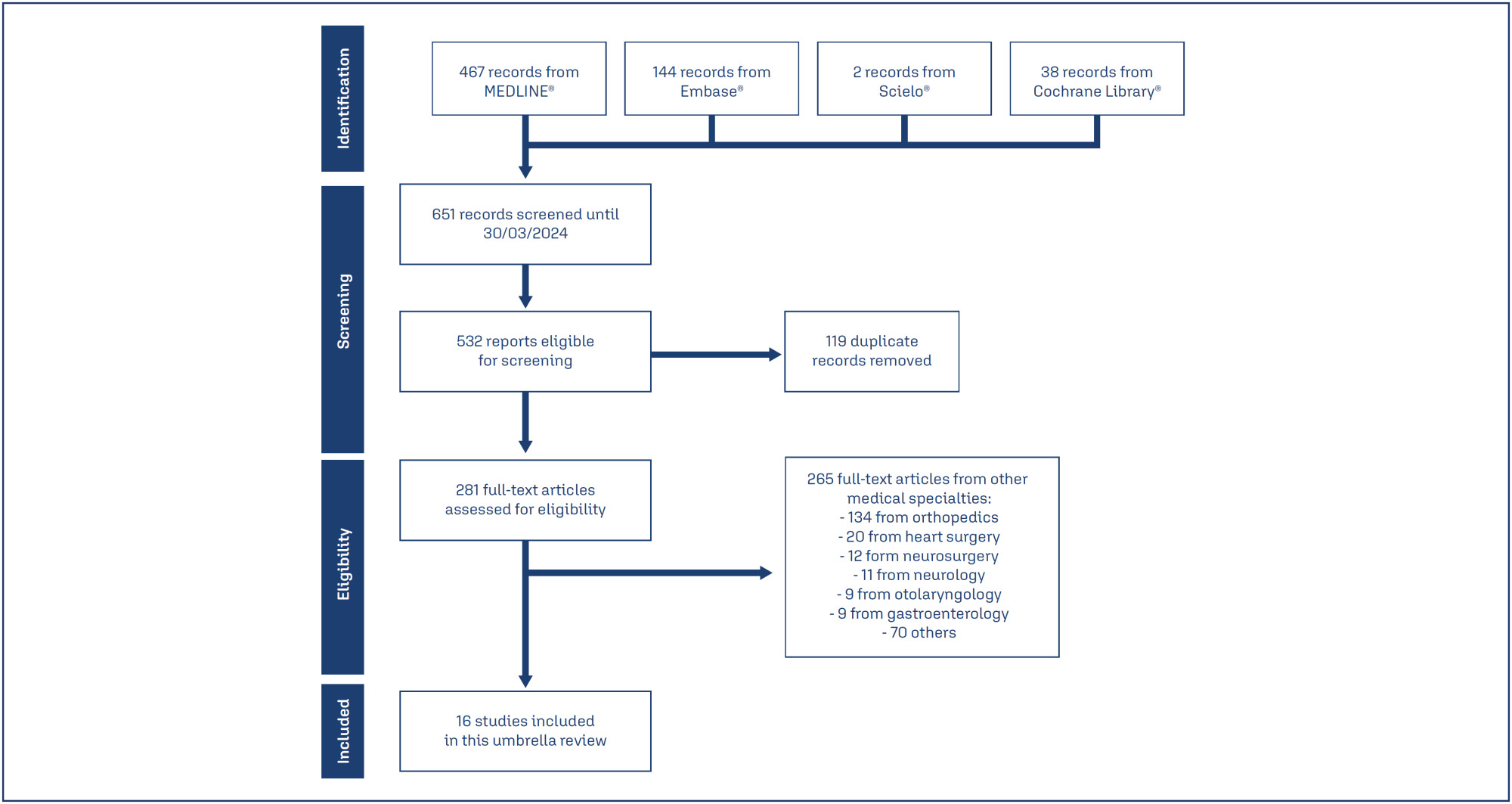
- Nicole Cristina Lottermann
-
Review Article03-18-2025
Short cervix and use of cervical pessary for preventing preterm birth in singleton and twin pregnancies: a systematic review and meta-analysis
- Ana Clara Felix de Farias Santos
 ,
, - Nicole dos Santos Pimenta
 ,
, - Ana Gabriela Alves Pereira
 ,
, - Gabriela Oliveira Gonçalves Molino
 ,
, - Maírla Marina Ferreira Dias
 , [ … ],
, [ … ], - Pedro Henrique Costa Matos da Silva

Abstract
Review ArticleShort cervix and use of cervical pessary for preventing preterm birth in singleton and twin pregnancies: a systematic review and meta-analysis
Revista Brasileira de Ginecologia e Obstetrícia. 2025;47:e-rbgo10
- Ana Clara Felix de Farias Santos
 ,
, - Nicole dos Santos Pimenta
 ,
, - Ana Gabriela Alves Pereira
 ,
, - Gabriela Oliveira Gonçalves Molino
 ,
, - Maírla Marina Ferreira Dias
 ,
, - Pedro Henrique Costa Matos da Silva

Views172See moreAbstract
Objective:
Preterm birth remains a significant contributor to neonatal morbidity and mortality. The use of cervical pessaries as an intervention for preventing preterm delivery in women with a short cervix has been a subject of interest. We evaluated the effectiveness of cervical pessary compared to standard care in preventing preterm delivery in women with a short cervix.
Data source:
Databases were systematically searched in PubMed, Cochrane, and Embase databases in December 2023.
Study selection:
Randomized clinical trials with the outcomes of interest were included.
Data collect:
We computed risk ratios for binary endpoints, with 95% confidence intervals. Heterogeneity was assessed using I2 statistics. Data were analyzed using R software (version 4.3.0). The primary outcomes of interest were preterm delivery before 37 weeks, and preterm delivery before 34 weeks.
Data synthesis:
Seventeen studies with 5,704 patients were included. The use of cervical pessary was associated with a decreased risk of preterm delivery before 37 (RR 0.88; 95% CI 0.81-0.96) and 34 weeks (RR 0.79; 95% CI 0.63-0.99) of gestation in twin pregnancies as compared to standard care without progesterone. There were no significant differences in preterm delivery in singleton pregnancy, neonatal outcomes, preterm premature rupture of the membranes or chorioamnionitis.
Conclusion:
The use of cervical pessary was associated with a significant reduction in preterm delivery at 34 and 37 weeks of gestation in twin pregnancies among patients with a short cervix compared to no treatment. No significant difference was found in singleton pregnancies or maternal outcomes.


This is an Open Access article distributed under the terms of the Creative Commons Attribution License, which permits unrestricted use, distribution, and reproduction in any medium, provided the original work is properly cited. 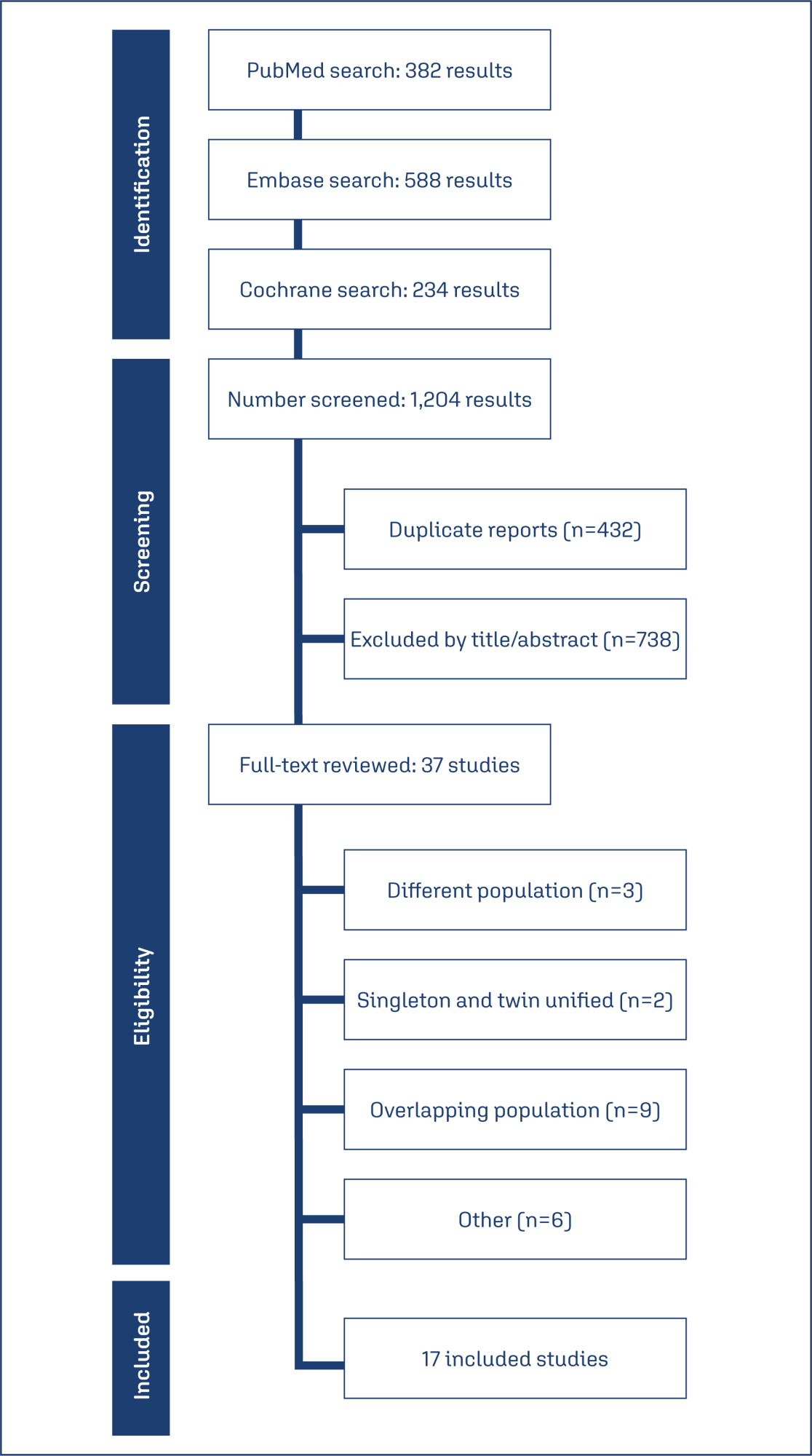
- Ana Clara Felix de Farias Santos
-
Short Communication03-18-2025
Contraception in adolescents with mental disorders: adherence and satisfaction in the use of depot medroxyprogesterone acetate
Revista Brasileira de Ginecologia e Obstetrícia. 2025;47:e-rbgo9
Abstract
Short CommunicationContraception in adolescents with mental disorders: adherence and satisfaction in the use of depot medroxyprogesterone acetate
Revista Brasileira de Ginecologia e Obstetrícia. 2025;47:e-rbgo9
Views172See moreAbstract
Objective:
To evaluate the continuation rate, satisfaction, and reasons for discontinuation of depot medroxyprogesterone acetate (DMPA) in adolescents treated in a mental health service.
Methods:
Prospective cohort study conducted in a reference unit for the care of adolescents with mental disorders (MDs) and intellectual disabilities (IDs). All patients received a gynecological consultation and an educational group on contraceptive methods. Sociodemographic data on age, education and gynecological data (menarche, coitarche, regularity of menstrual cycles and presence of symptoms) were collected. Follow-up was quarterly for 12 months, during which symptoms, desire to continue, and satisfaction with the use of the quarterly injectable were assessed.
Results:
Eight hundred and sixty-two sexually active adolescents were supported, 532 adolescents chose to use the quarterly injectable, and 69 of these agreed to participate in the study. The mean age of users was 15.5 years (SD=0.91). After 12 months of follow-up, 34 (49.3%) of the 69 adolescents continued to use the method and 36 (52.3%) were satisfied. Among the 33 (47.8%) who discontinued use, the most common reasons were irregular bleeding and weight gain.
Conclusions:
Adolescents with intellectual disabilities and/or other mental disorders showed a significant rate of continuation and satisfaction with the use of the depot medroxyprogesterone acetate at 12 months, and the most common reasons for discontinuation were irregular uterine bleeding and weight gain.


This is an Open Access article distributed under the terms of the Creative Commons Attribution License, which permits unrestricted use, distribution, and reproduction in any medium, provided the original work is properly cited. 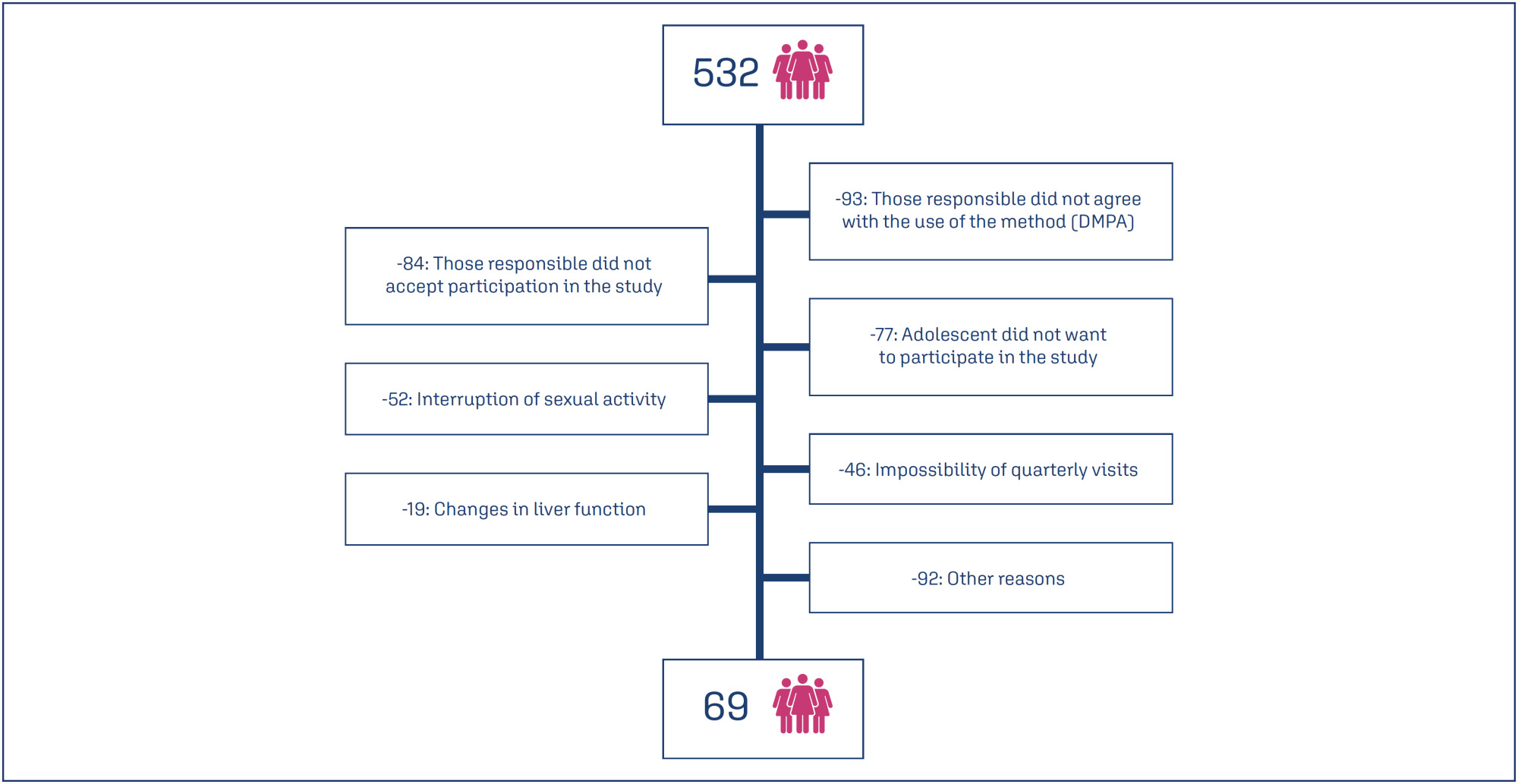
-
Original Article03-18-2025
The experience of pregnancy in the COVID-19 pandemic
- Mariana Corniani Lopes
 ,
, - Cheryl Tatano Beck
 ,
, - Zelina Hilária de Souza Rosa
 ,
, - Erika de Sá Vieira Abuchaim

Abstract
Original ArticleThe experience of pregnancy in the COVID-19 pandemic
Revista Brasileira de Ginecologia e Obstetrícia. 2025;47:e-rbgo8
- Mariana Corniani Lopes
 ,
, - Cheryl Tatano Beck
 ,
, - Zelina Hilária de Souza Rosa
 ,
, - Erika de Sá Vieira Abuchaim

Views187See moreAbstract
Objective:
To describe women’s experience of pregnancy during the COVID-19 pandemic.
Methods:
A qualitative study conducted in a private maternity hospital, from May, 2020 to November, 2021, with women aged ≥ 18 years, gestational age ≥ 36 weeks at birth and ≥ 24 hours post-partum. Data collected through semi-structured interviews, recorded, transcribed, and analyzed adopting Krippendorff’s Content Analysis as theoretical-methodological framework.
Results:
Four main themes emerged: Fear, Taking care and celebrating pregnancy: adjusting to the new reality, Harms of Isolation, and Benefits of Isolation. The fear of contamination and its impact on the health of mother and child resulted in the adoption of severe social isolation, including from those considered sources of support by the expecting mother. Overwhelmed, some of the participants reported loneliness and psychic suffering. The opportunity to focus on the pregnancy, the preparations for the arrival of the child, and the family made isolation a beneficial and positive period for other women.
Conclusion:
The experience of pregnancy in the Pandemic was an event outside of the ordinary and common. The expecting mother faced her worst fears on a daily basis and attended prenatal care, in order to ensure her child would be born healthy. The celebration of the baby’s life, amid so many deaths, had to be adjusted to the virtual environment. It was a tense, solitary, and ambiguous period, which demanded a lot from the mental health of some participants, but to others, brought advantages that would not have been possible in different times.


This is an Open Access article distributed under the terms of the Creative Commons Attribution License, which permits unrestricted use, distribution, and reproduction in any medium, provided the original work is properly cited. 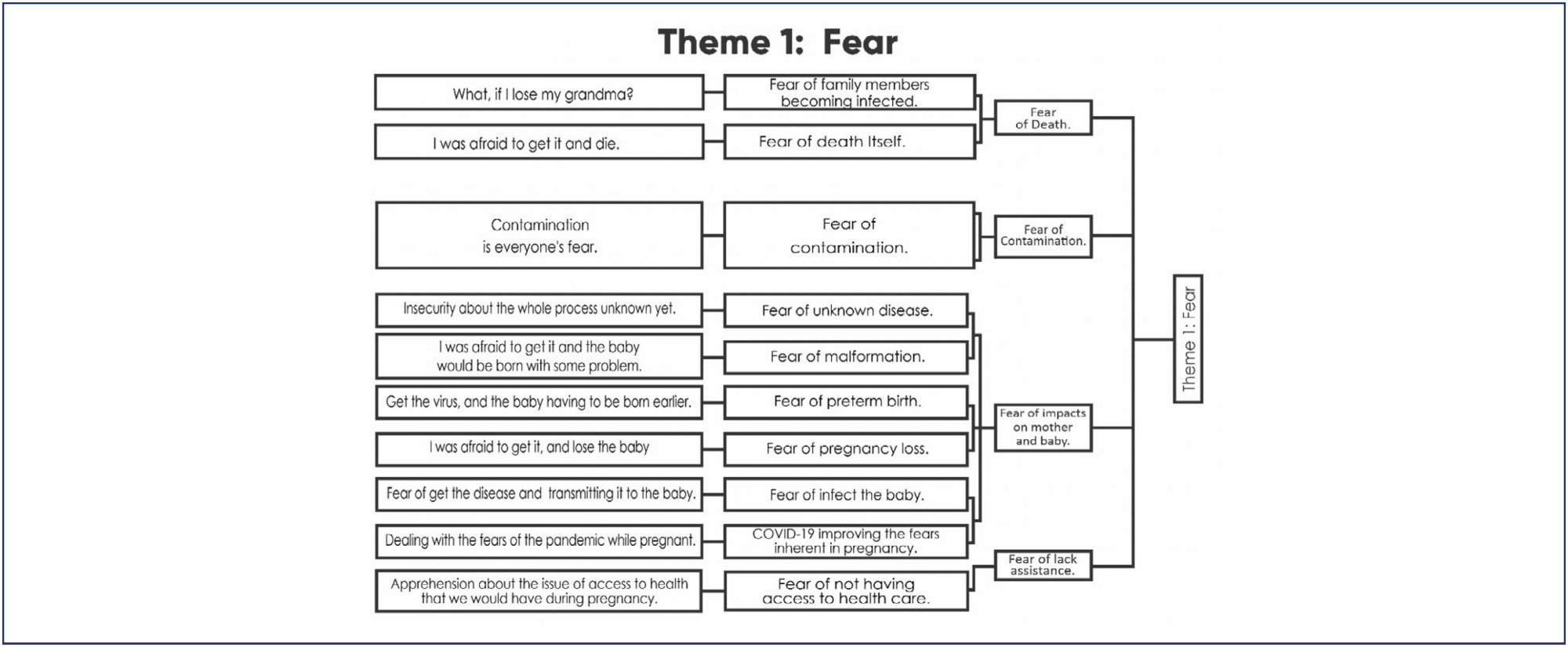
- Mariana Corniani Lopes
-
Original Article03-18-2025
Effect of COVID-19 on Brazilian cesarean and prematurity rates: a cross-sectional study
Revista Brasileira de Ginecologia e Obstetrícia. 2025;47:e-rbgo6
Abstract
Original ArticleEffect of COVID-19 on Brazilian cesarean and prematurity rates: a cross-sectional study
Revista Brasileira de Ginecologia e Obstetrícia. 2025;47:e-rbgo6
Views166See moreAbstract
Objective:
To investigate the relationship between prematurity and cesarean section rate in Brazil during the beginning of COVID-19 pandemic.
Methods:
Utilizing the Robson Classification, this study analyzed data from the Brazilian Ministry of Health’s Live Births Panel, comparing CSR) and group 10 (preterm deliveries) between 2019 (pre-pandemic) and 2021 (pandemic) in each of Brazilian states and the overall country. The prematurity and CSR were compared using prevalence ratio and confidence interval, and p-value was obtained. The variation of prematurity and CSR were compared through the coefficient of determination (R2).
Results:
A total of 5,522,910 deliveries were evaluated during the period. The CSR increased from 56.34% to 57.05% (p<0.01), and the frequency of preterm deliveries rose from 8.99% to 9.13% (p<0.01). The CSR increased in 23 States and decreased in 4 States, while the prematurity rate increased in 16 States and decreased in 10 States. A positive relationship between the increase of CSR and prematurity was observed during COVID-19, with an R2 value of 0.3121, suggesting a moderate association between these two variables.
Conclusion:
Between 2019 (pre-COVID-19 pandemic) and 2021 (the first full year of the COVID-19 pandemic), there was an increase in prematurity and CSR in Brazil. These increases were observed in most Brazilian states and may be correlated. However, it is impossible to establish a cause-effect relationship given the design of this study.


This is an Open Access article distributed under the terms of the Creative Commons Attribution License, which permits unrestricted use, distribution, and reproduction in any medium, provided the original work is properly cited. 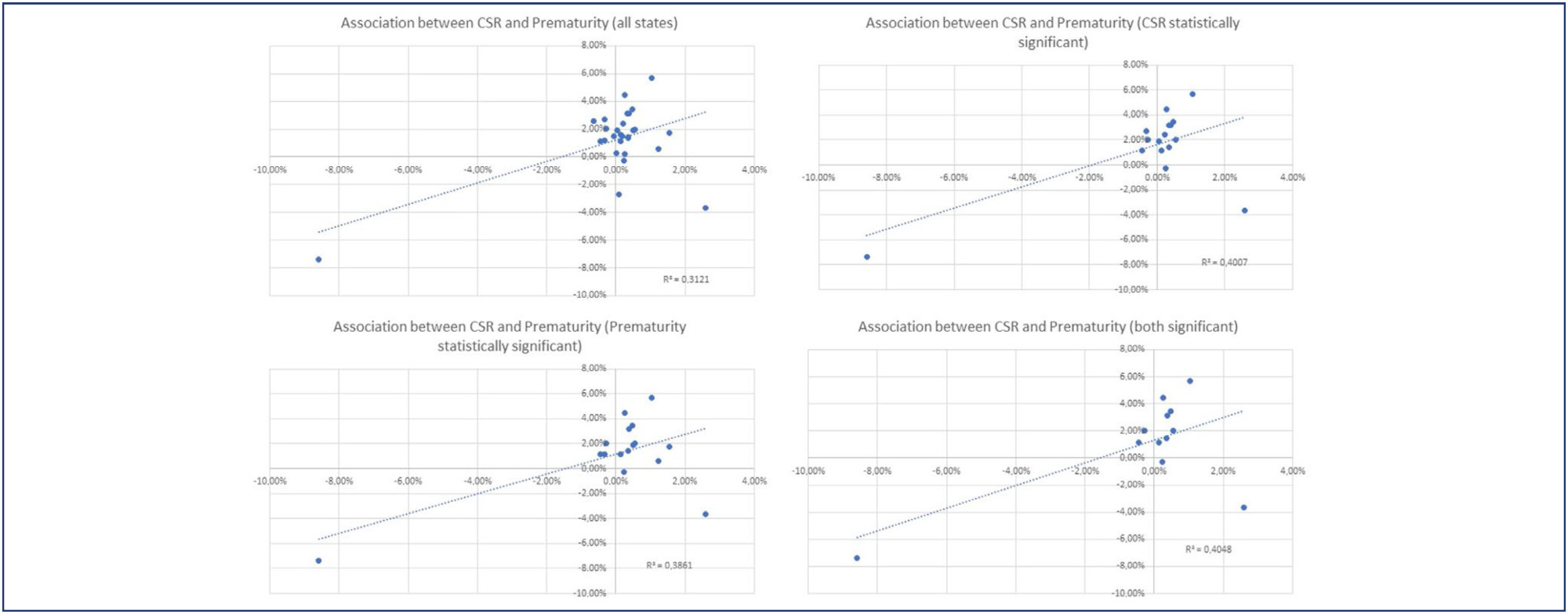
-
Original Article03-18-2025
Accurate evaluation of mode of delivery and labor progression with angle of progression: a prospective cross-sectional
Revista Brasileira de Ginecologia e Obstetrícia. 2025;47:e-rbgo5
Abstract
Original ArticleAccurate evaluation of mode of delivery and labor progression with angle of progression: a prospective cross-sectional
Revista Brasileira de Ginecologia e Obstetrícia. 2025;47:e-rbgo5
Views156See moreAbstract
Objective:
To determine the validity of the angle of progression (AoP) in predicting delivery mode among women in the second stage of labor.
Designs:
This prospective cohort study was conducted at the Obstetrics and Gynecology unit (OBGYN) of two hospitals in Vietnam. Transperineal ultrasound was performed for each woman to measure the progression angle in the second phase of labor.
Participants:
A total of 725 women with singleton pregnancies with cephalic presentation at term
Methods:
Transperineal ultrasound was used to measure the angle of progression in the second labor phase and to identify the delivery method.
Results:
The rate of vaginal birth in women with an AoP ≥ 120° on transperineal ultrasound was 70.2%. The optimal cutoff point of AOP ≥122° with sensitivity and specificity for vaginal birth were 87.8% and 80.7%, respectively the area under the ROC curve of 0.887 (p<0.0001). The study's sample size was restricted owing to deficiencies in resources and time.
Conclusion:
The likelihood of achieving spontaneous vaginal delivery can be predicted by the angle of progression measured with transperineal intrapartum ultrasonography during the second stage of labor in women.


This is an Open Access article distributed under the terms of the Creative Commons Attribution License, which permits unrestricted use, distribution, and reproduction in any medium, provided the original work is properly cited. 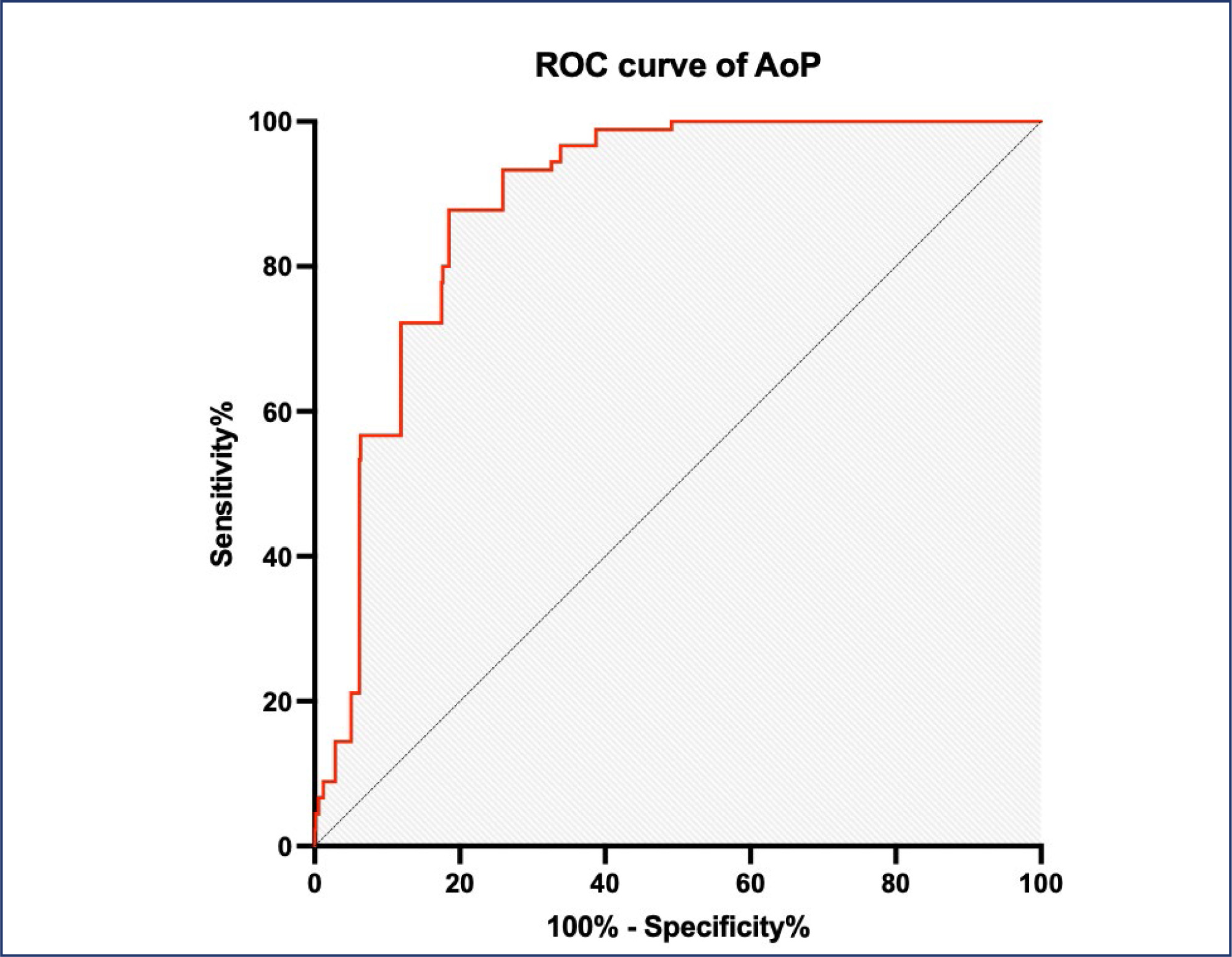
-
Original Article03-18-2025
Gastrin-releasing peptide receptor: a promising new biomarker to identify cervical precursor lesions and cancer
- Martina Lichtenfels
 ,
, - Rafaella Almeida Lima Nunes
 ,
, - Rossana Veronica Mendoza López
 ,
, - Camila Alves da Silva
 ,
, - Luiz Carlos Zeferino
 , [ … ],
, [ … ], - Lara Termini

Views137

This is an Open Access article distributed under the terms of the Creative Commons Attribution License, which permits unrestricted use, distribution, and reproduction in any medium, provided the original work is properly cited. Abstract
Original ArticleGastrin-releasing peptide receptor: a promising new biomarker to identify cervical precursor lesions and cancer
Revista Brasileira de Ginecologia e Obstetrícia. 2025;47:e-rbgo4
- Martina Lichtenfels
 ,
, - Rafaella Almeida Lima Nunes
 ,
, - Rossana Veronica Mendoza López
 ,
, - Camila Alves da Silva
 ,
, - Luiz Carlos Zeferino
 ,
, - Vanesca de Souza Lino
 ,
, - Adhemar Longatto-Filho
 ,
, - Louise De Brot
 ,
, - Silvia Helena Rabelo-Santos
 ,
, - Daniela Baumann Cornelio
 ,
, - Enrique Boccardo
 ,
, - Caroline Brunetto de Farias
 ,
, - Lara Termini

Views137Abstract
Objective:
This study aimed to verify the relation between gastrin-releasing peptide receptor (GRPR), oncogenic Human Papillomavirus (HPV) and cervical lesions severity.
Methods:
GRPR mRNA levels were evaluated in cervical cancer-derived cell lines and in primary keratinocytes expressing HPV16 oncogenes by RT-PCR. GRPR protein expression was assessed by immunohistochemistry in organotypic cell cultures derived from keratinocytes transduced with HPV16 oncogenes and in 208 cervical samples, including 59 non-neoplastic tissue, 28 cervical intraepithelial neoplasia grade 3 (CIN3), 44 squamous cell carcinomas (SCC) and 77 adenocarcinomas (ADC). Generic primers (GP5+/GP6+) were used to identify HPV infection in tissue samples. Experiments involving cell lines were analyzed through non-parametric tests (Kruskal Wallis), and Fisher’s Exact Test for human tissues samples. All statistical tests were considered significant at p <0.05. Immunohistochemical evaluation was conducted independently and blindly by two observers (AD- LO). Any discordant findings were resolved through discussion to reach a consensus score.
Results:
GRPR mRNA levels were not increased in cells expressing HPV16 or HPV18 oncogenes. However, at the protein level, GRPR was upregulated in organotypic cell cultures containing HPV oncogenes. Besides, it was identified an association between GRPR expression and cervical lesion severity (p < 0.0001). The detection rate of high-risk HPV DNA was directly correlated with cervical disease. Nonetheless, HPV infection was not directly associated with GRPR in cervical samples.
Conclusion:
GRPR expression is highly predictive of cervical lesion severity, irrespective of HPV infection and might contribute to improving patient’s therapeutic management as well as being used a marker of disease progression.
Key-words AdenocarcinomaCarcinoma, squamous cellGastrin-releasing peptide receptorHuman papillomavirusOncogenesPapillomavirus infectionsUterine cervical dysplasiaUterine cervical neoplasmsSee more

This is an Open Access article distributed under the terms of the Creative Commons Attribution License, which permits unrestricted use, distribution, and reproduction in any medium, provided the original work is properly cited. 
- Martina Lichtenfels
-
Review Article03-18-2025
Low-level laser therapy for nipple trauma and pain during breastfeeding: systematic review and meta-analysis
- Maria Victória Candida Gaitero
 ,
, - Ticiana Aparecida Alves de Mira
 ,
, - Edna Jéssica Lima Gondim
 ,
, - Simony Lira do Nascimento
 ,
, - Fernanda Garanhani Surita

Abstract
Review ArticleLow-level laser therapy for nipple trauma and pain during breastfeeding: systematic review and meta-analysis
Revista Brasileira de Ginecologia e Obstetrícia. 2025;47:e-rbgo3
- Maria Victória Candida Gaitero
 ,
, - Ticiana Aparecida Alves de Mira
 ,
, - Edna Jéssica Lima Gondim
 ,
, - Simony Lira do Nascimento
 ,
, - Fernanda Garanhani Surita

Views147Abstract
Objective:
This study aimed to investigate the effect of low-level laser therapy (LLLT) on nipple trauma and pain during breastfeeding through a systematic review with a meta-analysis of selected studies.
Source of the data:
A thorough search was conducted on March 22, 2022, using the databases PubMed, SciELO, LILACS, PEDro, CINAHL, EMBASE, ScienceDirect, Scopus, Google Scholar, MEDLINE, the Cochrane Library, Clinical Trials, Web of Science, TRIP, DARE, and ProQuest. The search terms included various combinations of low-level laser therapy, nipple pain, nipple trauma, and breastfeeding.
Studies selection:
Out of 107 articles identified, only three controlled and randomized clinical trials was included. The extracted data encompassed breast and trauma characteristics, treatment types, outcomes (pain and healing process), evaluation tools, LLLT usage, laser brand, and parameters.
Data collection:
Data extraction was performed using RAYYAN for systematic reviews. The risk of bias in the studies was evaluated.
Data synthesis:
Pain was measured using the visual analog scale (VAS). The included studies did not use validated tools for assessing physical conditions. All studies employed LLLT with a 660-nm wavelength, though there were variations in equipment power, energy dose, and application methods. The meta-analysis revealed an average difference of −0.60 points (95% CI: −1.52 to 0.31) in the VAS pain scores between the LLLT and control groups. No heterogeneity was observed among the studies (I2=0%), indicating no significant difference in pain relief between LLLT (red light) and control groups.
Conclusion:
LLLT may offer a promising option for managing breastfeeding-related complications, though further research is required.
Key-words Breast feedingLaser therapyLow level light therapyLow-level laserNipple painNipple traumaNipplesSee more

This is an Open Access article distributed under the terms of the Creative Commons Attribution License, which permits unrestricted use, distribution, and reproduction in any medium, provided the original work is properly cited. 
- Maria Victória Candida Gaitero
-
Review Article03-18-2025
Clinical repercussions of statin use during pregnancy: a review of the literature
- Joan Lins Serafim
 ,
, - Pedro Lucas Santos de Menezes Teles
 ,
, - Amanda Katharinne Souza Lima
 ,
, - Jéssica dos Santos Coelho
 ,
, - Paloma Luna Maranhão Conrado
 , [ … ],
, [ … ], - George Alessandro Maranhão Conrado

Abstract
Review ArticleClinical repercussions of statin use during pregnancy: a review of the literature
Revista Brasileira de Ginecologia e Obstetrícia. 2025;47:e-rbgo2
- Joan Lins Serafim
 ,
, - Pedro Lucas Santos de Menezes Teles
 ,
, - Amanda Katharinne Souza Lima
 ,
, - Jéssica dos Santos Coelho
 ,
, - Paloma Luna Maranhão Conrado
 ,
, - Valda Lúcia Moreira Luna
 ,
, - Pauliana Valéria Machado Galvão
 ,
, - George Alessandro Maranhão Conrado

Views126Abstract
Statins are the most widely used pharmacological class for treating hyperlipidemia, although they are contraindicated during pregnancy. This study aims to demonstrate the clinical effects of statins in pregnant women through an interactive review. Fifteen original articles were selected, in English or Portuguese, within of five years. Statins have not been associated with the development of fetal malformations and their use may be useful in preventing unfavorable cardiovascular outcomes, with the potential to reduce oxidative stress and angiogenic dysfunction. However, the use of statins to prevent pre-eclampsia in humans has not been properly clarified and further studies are needed. Pravastatin is considered safer than statins for use during pregnancy.
Key-words Antihypertensive agentsHydroxymethylglutaryl-CoA reductase inhibitorsPravastatinPre-eclampsiaPregnancyPregnant womanSee more

This is an Open Access article distributed under the terms of the Creative Commons Attribution License, which permits unrestricted use, distribution, and reproduction in any medium, provided the original work is properly cited. 
- Joan Lins Serafim
Search
Search in:
Tag Cloud
Pregnancy (252)Breast neoplasms (104)Pregnancy complications (104)Risk factors (103)Menopause (88)Ultrasonography (83)Cesarean section (78)Prenatal care (71)Endometriosis (70)Obesity (61)Infertility (57)Quality of life (55)prenatal diagnosis (51)Women's health (48)Postpartum period (46)Maternal mortality (45)Pregnant women (45)Breast (44)Prevalence (43)Uterine cervical neoplasms (43)
